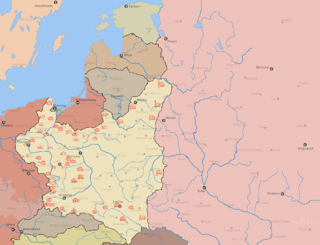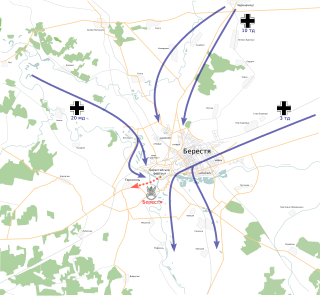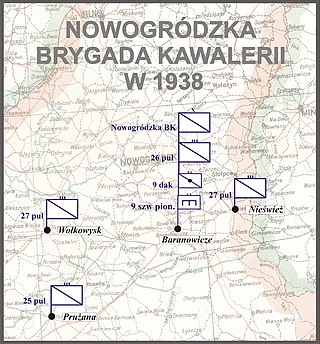
Operation Tempest was a series of uprisings conducted during World War II against occupying German forces by the Polish Home Army, the dominant force in the Polish resistance.

The Battle of Kock was the final battle in the invasion of Poland at the beginning of World War II in Europe. It took place between 2–5 October 1939, near the town of Kock, in Poland.

This article discusses the Polish order of battle during the invasion of Poland. In the late 1930s Polish headquarters prepared "Plan Zachód", a plan of mobilization of Polish Army in case of war with Germany. Earlier, the Poles did not regard the Germans as their main threat, priority was given to threat from the Soviets.

The Siege of Warsaw in 1939 was fought between the Polish Warsaw Army garrisoned and entrenched in Warsaw and the invading German Army.

The Battle of Brześć Litewski was a World War II battle involving German and Polish forces that took place between 14 and 17 September 1939, near the town of Brześć Litewski. After three days of heavy fights for the stronghold in the town of Brześć, the Germans captured the fortress and the Poles withdrew.
The Battle of Mława, otherwise known as the Defence of the Mława position, took place to the north of the town of Mława in northern Poland between 1 and 3 September 1939. It was one of the opening battles of the Invasion of Poland and World War II in general. It was fought between the forces of the Polish Modlin Army under General Krukowicz-Przedrzymirski and the German 3rd Army under General Georg von Küchler.
The 8th Infantry Division was a tactical unit of the Polish Army. It was active in the Polish-Bolshevik War, as well as during the Invasion of Poland in 1939. During World War II, the division was reformed twice as part of two distinct armed forces: once as part of the Home Army during the Warsaw Uprising and again as part of the Polish Army in the East.
The Polish 4th Infantry Division was created following Polish independence after the end of World War I. The division participated in the Polish–Ukrainian War in 1919. During World War II, the division existed as three wholly separate organizations, the original incarnation of the division as part of the pre-war Polish Army, the second incarnation armed and equipped by the western Allies, and another division armed and equipped and controlled by the Soviet Union. The second and third incarnations of this division existed simultaneously from 1944 until 1947.

The I Army Corps was a corps of the German army during World War II. It was active between 1934 and 1945, and participated in the Invasion of Poland, the Battle of France and the campaigns on the Eastern Front before eventually ending the war trapped in the Courland Pocket.
The Warsaw Armoured Motorized Brigade was a motorized unit of the Polish Army during the interbellum period. The brigade was one of two such units in Poland. Not fully formed by September 1, it was nonetheless partially combat ready and immediately rushed into battle during the Polish September Campaign. Following heavy losses during the Battle of Tomaszów Lubelski, it was disbanded on September 20, 1939.

15th "Greater Poland" Infantry Division was a unit of the Polish Army in the interbellum period. Founded on February 17, 1920, and based on the 2nd Greater Poland Rifles Division, it actively participated in the Polish-Soviet War, including the Kiev offensive (1920), and the Battle of Warsaw. After Polish victory, the Division pushed the Red Army out of northern Mazovia. It then fought in the Battle of the Niemen River.

Modlin Army was one of the Polish armies that were part of the Polish defense against the German Invasion of Poland. After heavy casualties in the battle of Mława, the Army was forced to abandon its positions near Warsaw around September 10; eventually it took part in the battle of Tomaszów Mazowiecki and surrendered afterwards.

The 27 Infantry Division, was a unit of the Polish Army in the inter-war period. It was created on 18 October 1920, as a result of reorganization of the Army, from units of the 2nd I.D., 3rd I.D., and 13th I.D. Its headquarters were located in Kowel, with units stationed in other Volhynian towns, such as Lutsk, Sarny and Wlodzimierz Wolynski. The Division's first commandant was General Gustaw Kuchinka.

Nowogródzka Cavalry Brigade was a cavalry unit of the Polish Army in the interbellum period. It was created on April 1, 1937, out of the Baranowicze Cavalry Brigade. It took its name from Nowogródek town. Its headquarters were stationed in the town of Baranowicze. It consisted of several units, garrisoned in several towns located in northeast part of pre-1939 Poland:

The Masovian Cavalry Brigade was a cavalry unit of the Polish Army in the interbellum period, which took part in the Polish September Campaign. It was created on April 1, 1937, out of former 1st Cavalry Brigade. Its headquarters were in Warsaw, with other units stationed in towns around the capital:

A Dowództwo Okręgu Korpusu was a military district of the Ministry of Military Affairs of the Second Polish Republic. It served as an organizational, mobilisational, and administrative body of the Polish Army, and all of Poland's local military units were subject to the Corps Commands.

Battle of Łomża was a series of armed engagements during the Nazi German and Soviet Invasion of Poland. The battle took place in and around the town of Łomża, on both sides of the Narew River. Polish forces successfully held a series of pre-First World War forts from repeated German attack before being forced to withdraw due to the position becoming untenable following their losses at the Battle of Wizna and Battle of Nowogród.
The Battle of Pułtusk (1939) was a battle between the Polish Army and the German Wehrmacht in Pultusk, Poland in the first week of World War II.
The battles of Baranowicze were the battles of Capt. Jerzy Dąbrowski's group in March and Col. Aleksander Boruszczak's group in April 1919 against the Red Army units fought in the early period of the Polish–Soviet War.

The defense of Ochota and Wola refers to military actions undertaken by the Polish Army on 8–9 September 1939 during the September campaign, in the districts of Ochota and Wola in Warsaw. The result was the repulsion of the German assault by the 4th Panzer Division and thus the thwarting of the German plan for a rapid capture of the Polish capital.













